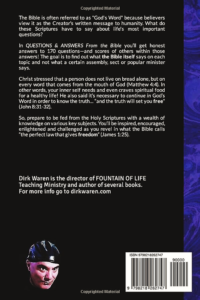How Old Is the EARTH According to the Bible?

The Bible does not say what the age of the Earth is and so people draw conclusions based on various data. It’s a non-essential issue and believers can hold to one position or another without it affecting their relationship with God or their Christian service. The more important an issue is, the more directly and fully the Bible addresses it. For instance, our moral responsibilities and the means to eternal salvation are clearly addressed at length, but less critical topics are not, such as the age of the Earth. When it comes to God’s Word “The main things are the plain things.”
That said, let’s consider the young Earth view, commonly held by Evangelicals, as well as the old Earth perspective and, more specifically, the gap theory, which isn’t as widely accepted.
Young Earth advocates maintain that the Earth is only about 6000 years old, a figure they get from adding up the life spans of biblical figures from the time of Adam. How do we reconcile this with the evidence of geologists, who say the Earth is about 4.5 billion years old (and the Universe 13.8 billion years old)? Supporters of young Earth creationism argue that, if God creates something in a mature state, like a human being, it would have the appearance of age and thus it is with the Earth.
How old was Adam one minute after God created him? One minute, but how old did Adam look? About 25-30 years old, certainly not like a newborn baby. The same principle can be applied to plants, trees, mammals, birds, fish, mountains, Earth, planets, stars and the Universe.
If doctors studied Adam’s body—his skeletal development, the size of his organs, his mental capacity, etc.—they’d conclude that he was an adult male of about 25-30 years of age. God’s creation of Adam in a mature state (in which his growth was perhaps accelerated to a brief period) is included in the creation account of Genesis 1-2 wherein God’s creation of the Heavens and Earth is also chronicled. If the LORD created Adam in a mature state—with the obvious appearance of age—is it not possible, even likely, that God did the same with the Earth & Universe?
Notice how the LORD refers to the creation of the Heavens and Earth:
“ ‘The Israelites are to observe the Sabbath, celebrating it for the generations to come as a lasting covenant. 17 It will be a sign between me and the Israelites forever, for in six days the LORD made the heavens and the earth, and on the seventh day he rested and was refreshed.’ ”
Exodus 31:16-17
We know from authentic science that the Earth & Universe appear to be ancient—billions of years old—but we see here that the LORD created them in six days as a testimony to the Israelites. The physical creation is incredibly old, but God evidently condensed the aging process of each phase of creation into six days. Since the LORD was addressing Moses & the Israelites in the above passage, and they understood the “six days” to be six literal days, it stands to reason that God meant six literal days.
Think about it like this: If you had a huge project that would take 50 years to accomplish, yet you had the power to condense the time into 5 minutes, would you do it? Of course you would. How much more so if your purpose for doing this was to illustrate a point to people? It’s the same principle with God’s creation of the Earth & Universe.
Consider those science videos where a plant is filmed over the course of a year or so and then this growth is condensed to seconds for viewers. If filmmakers can do this via cinematic wizardry, would the Almighty have a problem doing something similar with the initial creation of people, animals, plants, trees, mountains, canyons, planets, stars and galaxies? There’s even a blatant example in Scripture of God supernaturally condensing the growth-time of something in Jonah 4:6. So why wouldn’t the LORD do the same thing when creating the Earth & Universe?
Where do dinosaurs fit in this young Earth scenario? In the post-flood years, they largely died out due to changing climate, lack of food or disease. Much as threatening animals like lions, tigers, bears, crocogators and pachyderms have been killed or driven out of populated areas by humans, so the last vestige of land-dwelling dinosaurs were slain or driven out. This would explain the “slay the dragon” myth in so many cultures, as well as the ancient art testifying to humans and dinosaurs coexisting.
To see the proverbial big picture, the young Earth perspective is depicted in this interesting diagram.
As for the old Earth perspective, the top view is the gap theory, which speculates that there were billions of years between the first verse of Genesis 1 and the second verse. As such, Genesis 1:2 describes the Earth after some great cataclysm, which made the Earth “formless and empty”:
In the beginning God created the heavens [the Universe] and the earth. 2 Now the earth was formless and empty, darkness was over the surface of the deep, and the Spirit of God was hovering over the waters.
Genesis 1:1-2
The mystery of this passage is the obvious contrast between verses 1 and 2: The first verse says that God created the Universe and the Earth, but then verse 2 states that the Earth was formless, empty and dark. Since when does God create something that’s “formless and empty”?
Gap theorists argue that Isaiah 45:18 lends support: “He is God who formed the earth and made it, He established it and did not create it to be a waste place, but formed it to be inhabited” (NASB). The words “waste place” are one word in the Hebrew, tohu (TOH-hu), and this is the same word translated as “formless” in Genesis 1:2. This word means “formless,” “desolation,” “waste place,” “chaos” and “emptiness.” The hermeneutical principle that “Scripture interprets Scripture” applies: Isaiah 45:18 plainly states that God did not create the Earth to be tohu—formless, empty, chaotic, desolate, a waste place—yet Genesis 1:2 shows that the Earth was tohu sometime after the LORD created it.
Lending further support to this theory, they say, is the statement in Genesis 1:2: “Now the earth was formless and empty.” If you look at the footnote in the New International Version of the Bible it shows that the word ‘was’ could possibly be translated as “became” because the Hebrew verb hayah (haw-yaw) is often translated as such. As a matter of fact, it’s translated as “became” 59 times and “become” 164 times in the New International Version. However, it’s translated as “was” 305 times.
Further evidence can be observed in Hebrews 11:3, which states: “By faith we understand that the universe was formed at God’s command, so that what is seen was not made out of what was visible.” The word ‘formed’ in the Greek is katartizó (kat-ar-TID-zoh), which means “to complete,” “to perfect,” “make complete,” “mend,” “restore” and “bring into its proper condition (whether for the first time, or after a lapse).” While this doesn’t negate the young Earth theory, it’s friendly toward the gap theory.
Supporters of the gap theory argue that Jeremiah 4:23-26 lends additional support for their position as it gives us a picture of cataclysmic global judgment whereupon no living thing survives, which they say only fits the pre-Adamic context between Genesis 1:1 and 1:2. The prophet says in verse 23: “I looked at the earth and it was formless and empty; and at the heavens and their light was gone.” This is the exact same description as Genesis 1:2. ‘Formless’ is the same Hebrew word tohu and ‘empty’ (or ‘void’ in some translations) is the same Hebrew word bohu (BOH-hu). These Hebrew words appear together in Scripture only these two times and, in the case of Jeremiah 4:23, it’s clearly an occasion of global-spanning judgment.
Verse 25 goes on to say that the prophet couldn’t see any people on the planet, at least from the perspective of his vision, nor could he see any birds. We know there will be people and animals on the Earth after the Tribulation judgments noted in the book of Revelation because, after all, Christ will judge the living nations upon His return, which is The Sheep and Goat Judgment, aka The Judgment of Living Nations (Matthew 25:31-46). As such, adherents of the gap theory argue that Jeremiah 4:23-26 more likely refers to the Earth after a pre-Adamic cataclysm or judgment that took place between Genesis 1:1 and Genesis 1:2.
This cataclysm would explain the extinction of the dinosaurs, they argue.
Gap theorists also maintain that God’s command to the survivors of the Noahic flood to “Be fruitful and increase in number and fill the earth” (Genesis 9:1) meant to replenish the Earth, which is how the Hebrew word for ‘fill,’ male (maw-LAY), is translated in the KJV. This is the same word used in the similar command to Adam in Genesis 1:28, which suggests that it could also mean replenish in that context, particularly since it’s the same command from God given to two different sets of people.
Check out the responses from youth Earth advocates to these gap theory arguments; then consider the rebuttals by gap theorists. If you’re interested, this article does just that (it’s basically just the long version of this article). In any case, it’s healthy to consider opposing views and the support for each before drawing an informed conclusion or, at least, a hypothesis.
While I suppose I lean toward the young Earth position, I confess agnosticism on the topic. I wasn’t present when the LORD created the Universe and neither were you. The best we can do is make an educated guess based on biblical and scientific data, keeping in mind that, however old the Earth is, it has no bearing on one’s spiritual growth and service. Also keep in mind that this is decidedly a side issue. As it is said:
In essentials unity, in non-essentials liberty, in all things charity.
This article was edited from chapter 13 of…
- The print book is available here for only $11.99 (299 pages)
- The Kindle eBook is available here for just 99¢!
Both links allow you to “look inside” the book.
Related Topics:
Does the Bible Say the Earth is Flat or Spherical?
The Five Earths of the Bible (and the Eight Ages)
Dinosaurs — Where Do They Fit?
Leviathan and Behemoth — What Were They? (Dinosaurs)
Hermeneutics — Proper Bible Interpretation
Why is this World so Messed Up?
(Pseudo) Science Is the “New God” and Dubious Scientists Are the “New Gods”
comments powered by Disqus





